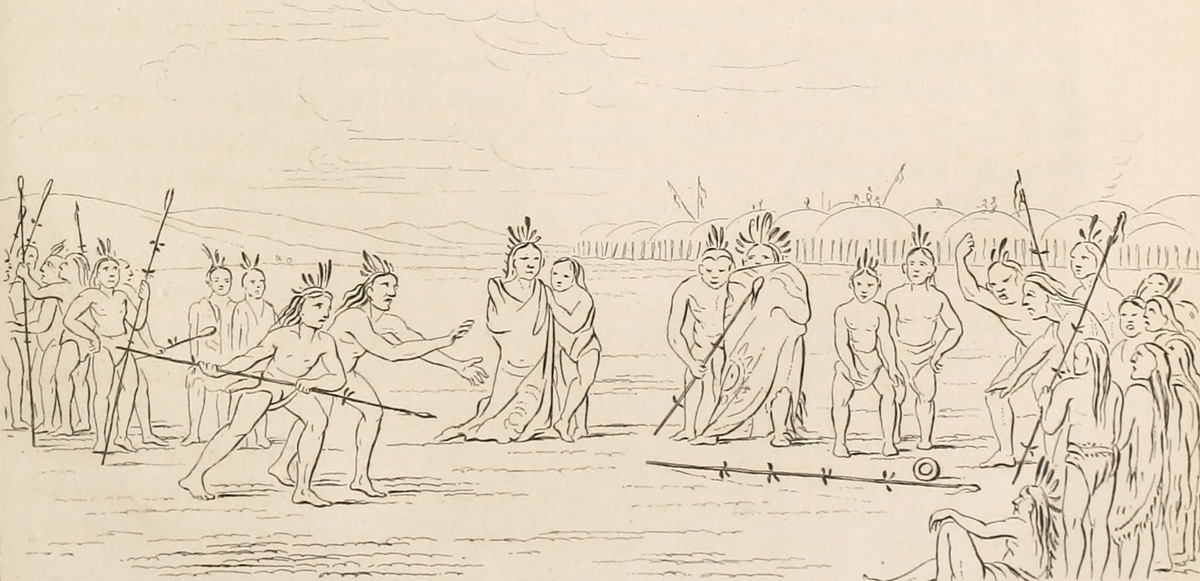Sgt. Ordway and two others visit two Mandan villages to trade for corn. They see men playing Tchung-kee—a game involving rolling a stone and sliding sticks across a large ice field. Clark‘s hunting party fails to find any buffalo.
A Soldier’s Letter Home
by Yellowstone Public Radio[1]Originally aired weekdays by Yellowstone Public Radio during the Bicentennial observance of 2003-2006. Narrated by Hal Hansen. Scripts by Whit Hansen and Ed Jacobson. Produced by Leni Holliman. © … Continue reading
Mandan Caches
I & 2 more of the party went up to the 1st & 2 villages of the Mandans. traded for a little corn &.C. they had all their corn in holes made in the Ground close in front of their lodges . . . . they gave us different kinds of victules & made us eat in everry lodge that we went in.
—John Ordway
Tchung-kee, a Mandan Game
although the day was cold & Stormy we Saw Several of the chiefs and warries were out at a play . . . . they had a place fixed across their green from the head chiefs house across abt. 50 yds. to the 2 chiefs lodge, which was Smothe as a house flour [floor] they had a Battery fixed for the rings to Stop against. two men would run at a time with Each a Stick & one carried a ring. they run abt. half way and then Slide their Sticks after the ring. they had marks made for the Game but I do not understand how they count the game.
—John Ordway
Catlin’s Description
This game is a very difficult one to describe, ao as to give an exact idea of it, unless one can see it played-it is a game of great beauty and fine bodily exercise, and these people become excessively fascinated with it ; often gambling away every thing they possess, and even sometimes, when everything else was gone, have been known to stake their liberty upon the issue of these games, offering themselves as slaves to their opponents in case they get beaten.[2]George Catlin, Letters and Notes on the Manners, Customs, and Condition of the North American Indians (London: Tosswill and Myer, 1841) 1:132-33.
Unsuccessful Hunt
Saw no buffalow, I concluded to return to the Fort & hunt on each Side of the river on our return which we did without Success— the Snow fell 1½ inches deep last night. wind North— on my return to the fort found Several Chiefs there
—William Clark
Weather Diary
Ther. at rise
Weather Wind at rise
Thert. at 4 P.M. Weather Wind at 4 P.M. River 8 below cloudy after snow W. 4 cloudy after snow W. snow fell one ½ inch— visited by the big man & the big white inform me that many buffaloe have visited the Grosventers [Hidatsas] on the opposite side of the river they came from the West.
—Meriwether Lewis[3]To assist the reader, the editor of this web page has omitted the date column, merged the “River” columns, and spelled out some abbreviations.
Fort Mandan is a High Potential Historic Site along the Lewis and Clark National Historic Trail managed by the U.S. National Park Service. The North Dakota Department of Parks and Recreation manages a modern reconstruction and the Lewis and Clark Interpretive Center located at US Hwy 83 and ND Hwy 200A.
Knife River Indian Villages National Historic Site is a High Potential Historic Site along the Lewis and Clark National Historic Trail managed by the U.S. National Park Service. A unit of the National Park System, the site is located at 564 County Road 37, one-half mile north of Stanton, North Dakota. It has exhibits, trails, and a visitor center.
Notes
| ↑1 | Originally aired weekdays by Yellowstone Public Radio during the Bicentennial observance of 2003-2006. Narrated by Hal Hansen. Scripts by Whit Hansen and Ed Jacobson. Produced by Leni Holliman. © 2003 by Yellowstone Public Radio. |
|---|---|
| ↑2 | George Catlin, Letters and Notes on the Manners, Customs, and Condition of the North American Indians (London: Tosswill and Myer, 1841) 1:132-33. |
| ↑3 | To assist the reader, the editor of this web page has omitted the date column, merged the “River” columns, and spelled out some abbreviations. |
Experience the Lewis and Clark Trail
The Lewis and Clark Trail Experience—our sister site at lewisandclark.travel—connects the world to people and places on the Lewis and Clark Trail.
Discover More
- The Lewis and Clark Expedition: Day by Day by Gary E. Moulton (University of Nebraska Press, 2018). The story in prose, 14 May 1804–23 September 1806.
- The Lewis and Clark Journals: An American Epic of Discovery (abridged) by Gary E. Moulton (University of Nebraska Press, 2003). Selected journal excerpts, 14 May 1804–23 September 1806.
- The Lewis and Clark Journals. by Gary E. Moulton (University of Nebraska Press, 1983–2001). The complete story in 13 volumes.




